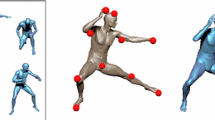Abstract
In this work we consider inverse modeling of the shape of cells in the outermost layer of human skin. We propose a novel algorithm that combines mathematical shape optimization with high-performance computing. Our aim is to fit a parabolic model for drug diffusion through the skin to data measurements. The degree of freedom is not the permeability itself, but the shape that distinguishes regions of high and low diffusivity. These are the cells and the space in between. The key part of the method is the computation of shape gradients, which are then applied as deformations to the finite element mesh, in order to minimize a tracking type objective function. Fine structures in the skin require a very high resolution in the computational model. We therefor investigate the scalability of our algorithm up to millions of discretization elements.





Similar content being viewed by others
Notes
HLRS, Stuttgart, Germany, http://www.hlrs.de/systems/platforms/cray-xe6-hermit/
References
Scheuplein, R.J., Blank, I.H.: Permeability of the skin. Physiol. Rev. 51(4), 702–747 (1971)
Barry, B.W.: Modern methods of promoting drug absorption through the skin. Mol. Aspects Med. 12(3), 195–241 (1991)
Jepps, O.G., Dancik, Y., Anissimov, Y.G., Roberts, M.S.: Modeling the human skin barrier–Towards a better understanding of dermal absorption. Adv. Drug Deliv. Rev. 65(2), 152–168 (2013)
Querleux, B.: Computational Biophysics of the Skin. Pan Stanford Publishing, Serra Mall (2014)
Mitragotri, S., Anissimov, Y.G., Bunge, A.L., Frasch, H.F., Guy, R.H., Hadgraft, J., Kasting, G.B., Lane, M.E., Roberts, M.S.: Mathematical models of skin permeability: an overview. Int. J. Pharm. 418(1), 115–129 (2011)
Naegel, A., Heisig, M., Wittum, G.: Detailed modeling of skin penetration—An overview. Adv. Drug Deliv. Rev. 65(2), 191–207 (2013). Modeling the human skin barrier - Towards a better understanding of dermal absorption
Naegel, A., Heisig, M., Wittum, G.: A comparison of two- and three-dimensional models for the simulation of the permeability of human stratum corneum. Eur. J. Pharm. Biopharm. 72(2), 332–338 (2009). Special Section: Biological Barriers and Nanomedicine- Advanced Drug Delivery and Predictive non vivo Testing Technologies
Muha, I., Naegel, A., Stichel, S., Grillo, A., Heisig, M., Wittum, G.: Effective diffusivity in membranes with tetrakaidekahedral cells and implications for the permeability of human stratum corneum. J. Membr. Sci. 368, 18–25 (2011)
Nitsche, J.M., Kasting, G.B.: A microscopic multiphase diffusion model of viable epidermis permeability. Biophys. J. 104(10), 2307–2320 (2013)
Schmidt, S., Ilic, C., Schulz, V., Gauger, N.R.: Three-dimensional large-scale aerodynamic shape optimization based on shape calculus. AIAA J. 51(11), 2615–2627 (2013)
Borzì, A., Schulz, V.: Computational optimization of systems governed by partial differential equations. Number 08 in SIAM book series on Computational Science and Engineering. SIAM Philadelphia (2012)
Schulz, V., Siebenborn, M., Welker, K.: Structured inverse modeling in parabolic diffusion problems. SIAM Control (submitted) (2014). arXiv:1409.3464
Meyer, M., Desbrun, M., Schöder, P., Barr, A.H.: Discrete differential-geometry operators for triangulated 2-manifolds. In: Hege, H.C., Polthier, K. (eds.) Visualization and Mathematics III, pp. 35–57, Springer, Berlin (2003)
Vogel, A., Reiter, S., Rupp, M., Nägel, A., Wittum, G.: Ug 4: a novel flexible software system for simulating pde based models on high performance computers. Comput. Vis. Sci. 16(4), 165–179 (2013)
Reiter, S., Vogel, A., Heppner, I., Rupp, M., Wittum, G.: A massively parallel geometric multigrid solver on hierarchically distributed grids. Comput. Vis. Sci. 16(4), 151–164 (2013)
Helenbrook, B.T.: Mesh deformation using the biharmonic operator. Int. J. Numer. Methods Eng. 56(7), 1007–1021 (2003)
Acknowledgments
This research is funded by the Deutsche Forschungsgemeinschaft (DFG) as part of the collaborative “Exasolvers” project in the Priority Program 1648 ”Software for Exascale Computing” (SPPEXA). The authors gratefully acknowledge the computing time granted by the HLRS, Stuttgart, Germany, and provided on the supercomputer Hermit.
Author information
Authors and Affiliations
Corresponding author
Additional information
Communicated by: Rolf Krause.
Rights and permissions
About this article
Cite this article
Nägel, A., Schulz, V., Siebenborn, M. et al. Scalable shape optimization methods for structured inverse modeling in 3D diffusive processes. Comput. Visual Sci. 17, 79–88 (2015). https://doi.org/10.1007/s00791-015-0248-9
Received:
Accepted:
Published:
Issue Date:
DOI: https://doi.org/10.1007/s00791-015-0248-9




